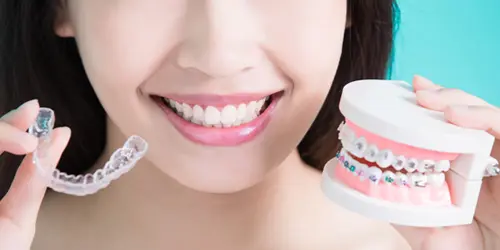Dental fillings are materials used to fill cavities or holes in teeth caused by decay. In this blog, our pediatric dentist in Queens will tell you about the most common types of filling for teeth.
What are the Different Types of Fillings?
Amalgam
Amalgam fillings, also known as silver fillings, are a type of dental filling made from a mixture of metals, including silver, copper, and tin. They have been used for over 150 years and are still widely used today.
The fillings are known for their durability and long-lasting nature and are often used for fillings in the back teeth, where the forces of chewing are the strongest. They are also relatively inexpensive and easy to place. However, amalgam fillings can be noticeable and may not match the color of natural teeth, which may be an aesthetic concern. Additionally, they are not recommended for people who are allergic to metal.
Composite
Composite fillings, also known as white fillings, are a type of dental filling made from a mixture of plastic and fine glass particles. They are designed to closely match the color of natural teeth, making them a popular choice for fillings in visible areas such as front teeth. They are applied in layers directly to the tooth and then hardened with a special light.
Composite fillings are considered a more aesthetic option compared to amalgam fillings, as they can be closely matched to the color of natural teeth. They are also considered to be a more conservative option as they require less removal of healthy tooth structure compared to amalgam fillings.
They are also biocompatible, which means that they do not react with the body.
However, composite fillings may not be as durable as amalgam fillings and may need to be replaced sooner. They also tend to be more expensive than amalgam fillings.
Porcelain
Porcelain fillings, also known as inlays or onlays, are a type of dental filling that are custom-made in a laboratory and then cemented into place. They are made from a material called dental porcelain, which is a type of ceramic material that is highly durable and closely matches the color of natural teeth.
Porcelain fillings are considered a more aesthetic option compared to composite and amalgam fillings, as they can be closely matched to the color of natural teeth. They are also considered to be a more conservative option, as they require less removal of healthy tooth structure compared to traditional fillings. They are particularly useful in cases of moderate to large cavities and where a more natural-looking tooth is desired.
On the other hand, they are more expensive than other types of fillings, and they require multiple appointments to be completed. They also may not be suitable for everyone as they are not recommended for patients who have weak teeth or have undergone previous root canal treatment.
Gold
Gold fillings, also known as gold inlays or onlays, are a type of dental filling made from a gold alloy. They are custom-made in a laboratory and then cemented into place.
Gold fillings are known for their durability and long-lasting nature, and they can last for decades and withstand the forces of chewing and grinding. They are also biocompatible and do not cause allergic reactions. They are a good option for people who have metal allergies or are sensitive to other types of fillings.
Gold fillings are also considered a more aesthetic option compared to amalgam fillings, as they can be closely matched to the color of natural teeth. However, they are an expensive option, and they may not be the most esthetically pleasing option. They also require multiple appointments to be completed.
Gold fillings are not as widely used as other types of fillings and are mostly used on back teeth or in situations where the filling will not be visible in the smile.
Glass ionomer
Glass Ionomer fillings are a type of dental filling made from a mixture of acrylic and glass powder. They are designed to bond chemically to tooth structure and release fluoride, making them a popular choice for filling teeth where tooth decay is close to the pulp (nerve) of the tooth.
They are also used in the treatment of sensitive teeth and as a base under composite fillings.
Glass ionomer fillings are considered a conservative option because they require less removal of healthy tooth structure compared to other types of fillings. They are also biocompatible, which means that they do not react with the body. They are also relatively inexpensive and easy to place.
However, they are not as durable as other types of fillings and may need to be replaced sooner. They also may not match the color of natural teeth as well as composite fillings and are not recommended for fillings in highly visible areas of the mouth.
Silver diamine fluoride
Silver diamine fluoride (SDF) is a liquid dental treatment that can be applied to teeth to help prevent tooth decay. It contains silver, which has antimicrobial properties, and fluoride, which helps to strengthen tooth enamel. The treatment is applied to the affected area of the tooth, where it can help to stop or slow the progression of cavities and may also be used as a preventative measure to help protect against future tooth decay. SDF is commonly used as an alternative to traditional dental fillings, especially in hard-to-reach areas or in patients who have difficulty tolerating traditional procedures.
What’s the Best Type of Dental Filling For You?
The best type of dental filling for your teeth will depend on the specific needs of your individual case. Some factors to consider include the following:
#1 – Location of the cavity
Different types of fillings may be more suitable for certain areas of the mouth. For example, composite fillings are often used for front teeth, as they can be matched to the color of the tooth, while amalgam fillings are typically used for back teeth.
#2 – Size and depth of the cavity
Larger cavities may require more extensive treatment, such as a crown or inlay.
#3 – Your personal preferences
Some people may prefer the appearance of composite fillings, while others may prefer the durability of amalgam fillings.
#4 – Budget
Different dental fillings have different costs, which may affect the decision.
It is important to discuss your options with your dentist, who can perform an examination of your teeth and recommend the best dental fillings in Queens for your specific needs. They will also be able to provide you with the pros and cons of each option so that you can make an informed decision.
PCO Dental Has Many Types of Fillings Available!
With PCO Dental, we have many dental filling options for you to choose from. You may schedule a consultation or contact us so we can guide you in terms of which dental filling suits your teeth the best.
You can also book online, so it’s much more convenient on your end. We look forward to helping you get dental filling for your teeth!
Tags: Dental Fillings, Orthodontist Queens NY, Pediatric dentist Long Island NY, Types of Fillings


